Managing People and Systems: Motivation Theories Report
VerifiedAdded on 2022/12/05
|8
|2036
|61
Report
AI Summary
This report provides an overview of several key motivation theories, including Herzberg's two-factor theory, Maslow's hierarchy of needs, and Vroom's expectancy theory, and their application in an organizational setting. It explores how these theories can be used to enhance employee motivation, engagement, and productivity within the modern workplace, particularly in light of the shift to remote work. The report delves into the practical implications of each theory, offering insights into how companies can create a positive and supportive work environment that meets the needs of their employees. It also examines the application of these theories in a modern context and draws conclusions regarding the importance of motivation in achieving organizational objectives. The report concludes by emphasizing the critical role of motivation in driving employee efforts and organizational success.
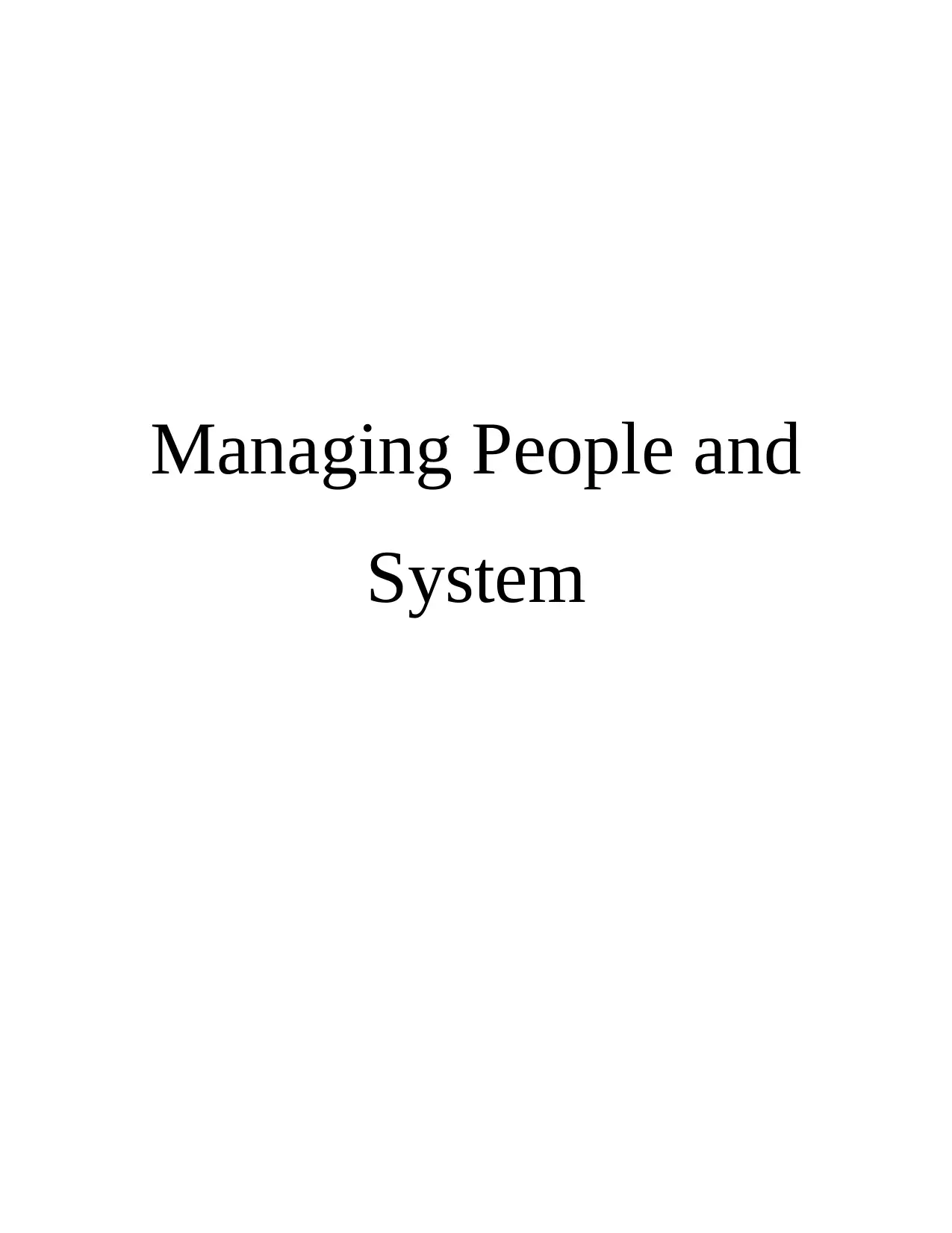
Managing People and
System
System
Paraphrase This Document
Need a fresh take? Get an instant paraphrase of this document with our AI Paraphraser
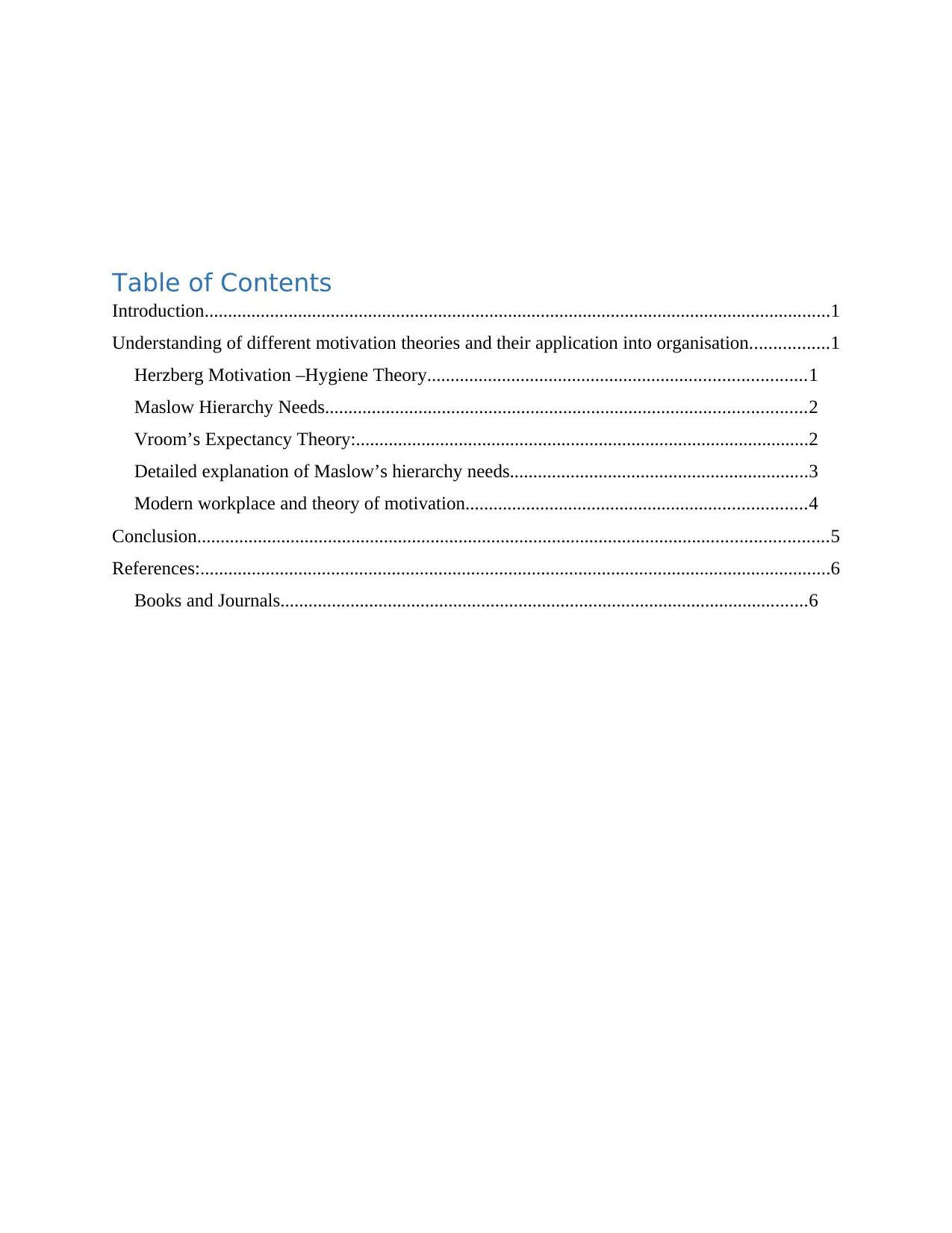
Table of Contents
Introduction......................................................................................................................................1
Understanding of different motivation theories and their application into organisation.................1
Herzberg Motivation –Hygiene Theory.................................................................................1
Maslow Hierarchy Needs.......................................................................................................2
Vroom’s Expectancy Theory:.................................................................................................2
Detailed explanation of Maslow’s hierarchy needs................................................................3
Modern workplace and theory of motivation.........................................................................4
Conclusion.......................................................................................................................................5
References:.......................................................................................................................................6
Books and Journals.................................................................................................................6
Introduction......................................................................................................................................1
Understanding of different motivation theories and their application into organisation.................1
Herzberg Motivation –Hygiene Theory.................................................................................1
Maslow Hierarchy Needs.......................................................................................................2
Vroom’s Expectancy Theory:.................................................................................................2
Detailed explanation of Maslow’s hierarchy needs................................................................3
Modern workplace and theory of motivation.........................................................................4
Conclusion.......................................................................................................................................5
References:.......................................................................................................................................6
Books and Journals.................................................................................................................6
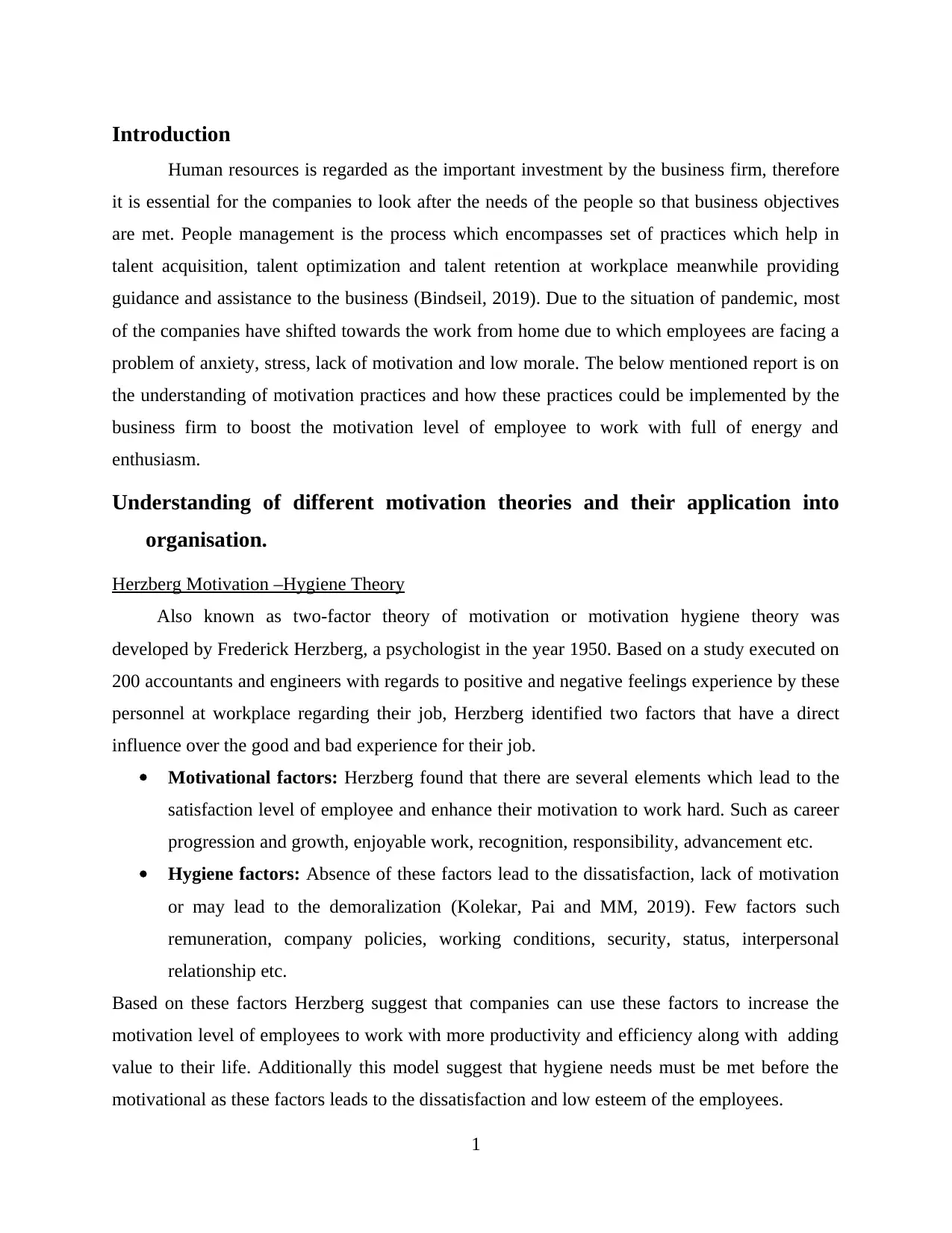
Introduction
Human resources is regarded as the important investment by the business firm, therefore
it is essential for the companies to look after the needs of the people so that business objectives
are met. People management is the process which encompasses set of practices which help in
talent acquisition, talent optimization and talent retention at workplace meanwhile providing
guidance and assistance to the business (Bindseil, 2019). Due to the situation of pandemic, most
of the companies have shifted towards the work from home due to which employees are facing a
problem of anxiety, stress, lack of motivation and low morale. The below mentioned report is on
the understanding of motivation practices and how these practices could be implemented by the
business firm to boost the motivation level of employee to work with full of energy and
enthusiasm.
Understanding of different motivation theories and their application into
organisation.
Herzberg Motivation –Hygiene Theory
Also known as two-factor theory of motivation or motivation hygiene theory was
developed by Frederick Herzberg, a psychologist in the year 1950. Based on a study executed on
200 accountants and engineers with regards to positive and negative feelings experience by these
personnel at workplace regarding their job, Herzberg identified two factors that have a direct
influence over the good and bad experience for their job.
Motivational factors: Herzberg found that there are several elements which lead to the
satisfaction level of employee and enhance their motivation to work hard. Such as career
progression and growth, enjoyable work, recognition, responsibility, advancement etc.
Hygiene factors: Absence of these factors lead to the dissatisfaction, lack of motivation
or may lead to the demoralization (Kolekar, Pai and MM, 2019). Few factors such
remuneration, company policies, working conditions, security, status, interpersonal
relationship etc.
Based on these factors Herzberg suggest that companies can use these factors to increase the
motivation level of employees to work with more productivity and efficiency along with adding
value to their life. Additionally this model suggest that hygiene needs must be met before the
motivational as these factors leads to the dissatisfaction and low esteem of the employees.
1
Human resources is regarded as the important investment by the business firm, therefore
it is essential for the companies to look after the needs of the people so that business objectives
are met. People management is the process which encompasses set of practices which help in
talent acquisition, talent optimization and talent retention at workplace meanwhile providing
guidance and assistance to the business (Bindseil, 2019). Due to the situation of pandemic, most
of the companies have shifted towards the work from home due to which employees are facing a
problem of anxiety, stress, lack of motivation and low morale. The below mentioned report is on
the understanding of motivation practices and how these practices could be implemented by the
business firm to boost the motivation level of employee to work with full of energy and
enthusiasm.
Understanding of different motivation theories and their application into
organisation.
Herzberg Motivation –Hygiene Theory
Also known as two-factor theory of motivation or motivation hygiene theory was
developed by Frederick Herzberg, a psychologist in the year 1950. Based on a study executed on
200 accountants and engineers with regards to positive and negative feelings experience by these
personnel at workplace regarding their job, Herzberg identified two factors that have a direct
influence over the good and bad experience for their job.
Motivational factors: Herzberg found that there are several elements which lead to the
satisfaction level of employee and enhance their motivation to work hard. Such as career
progression and growth, enjoyable work, recognition, responsibility, advancement etc.
Hygiene factors: Absence of these factors lead to the dissatisfaction, lack of motivation
or may lead to the demoralization (Kolekar, Pai and MM, 2019). Few factors such
remuneration, company policies, working conditions, security, status, interpersonal
relationship etc.
Based on these factors Herzberg suggest that companies can use these factors to increase the
motivation level of employees to work with more productivity and efficiency along with adding
value to their life. Additionally this model suggest that hygiene needs must be met before the
motivational as these factors leads to the dissatisfaction and low esteem of the employees.
1
⊘ This is a preview!⊘
Do you want full access?
Subscribe today to unlock all pages.

Trusted by 1+ million students worldwide
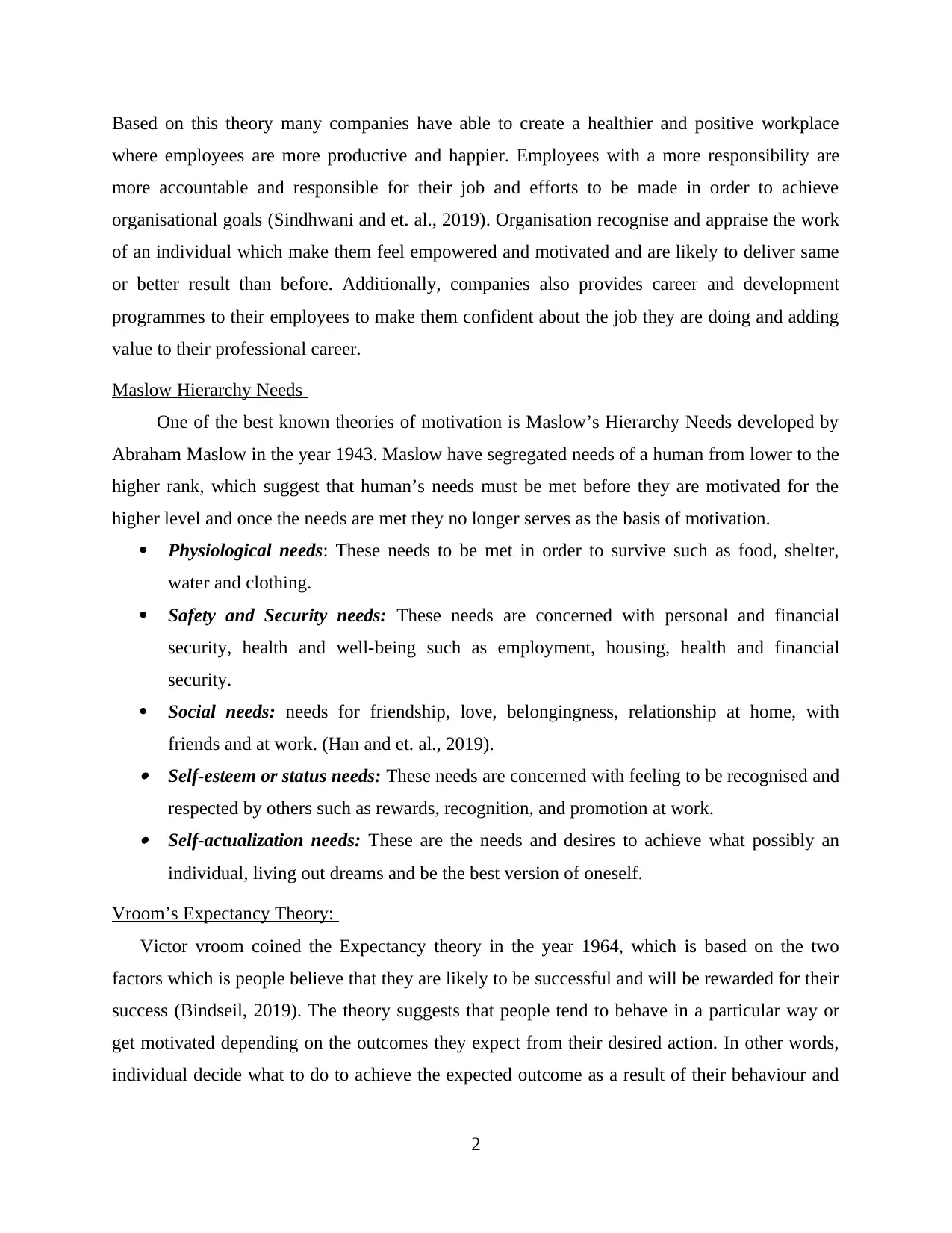
Based on this theory many companies have able to create a healthier and positive workplace
where employees are more productive and happier. Employees with a more responsibility are
more accountable and responsible for their job and efforts to be made in order to achieve
organisational goals (Sindhwani and et. al., 2019). Organisation recognise and appraise the work
of an individual which make them feel empowered and motivated and are likely to deliver same
or better result than before. Additionally, companies also provides career and development
programmes to their employees to make them confident about the job they are doing and adding
value to their professional career.
Maslow Hierarchy Needs
One of the best known theories of motivation is Maslow’s Hierarchy Needs developed by
Abraham Maslow in the year 1943. Maslow have segregated needs of a human from lower to the
higher rank, which suggest that human’s needs must be met before they are motivated for the
higher level and once the needs are met they no longer serves as the basis of motivation.
Physiological needs: These needs to be met in order to survive such as food, shelter,
water and clothing.
Safety and Security needs: These needs are concerned with personal and financial
security, health and well-being such as employment, housing, health and financial
security.
Social needs: needs for friendship, love, belongingness, relationship at home, with
friends and at work. (Han and et. al., 2019). Self-esteem or status needs: These needs are concerned with feeling to be recognised and
respected by others such as rewards, recognition, and promotion at work. Self-actualization needs: These are the needs and desires to achieve what possibly an
individual, living out dreams and be the best version of oneself.
Vroom’s Expectancy Theory:
Victor vroom coined the Expectancy theory in the year 1964, which is based on the two
factors which is people believe that they are likely to be successful and will be rewarded for their
success (Bindseil, 2019). The theory suggests that people tend to behave in a particular way or
get motivated depending on the outcomes they expect from their desired action. In other words,
individual decide what to do to achieve the expected outcome as a result of their behaviour and
2
where employees are more productive and happier. Employees with a more responsibility are
more accountable and responsible for their job and efforts to be made in order to achieve
organisational goals (Sindhwani and et. al., 2019). Organisation recognise and appraise the work
of an individual which make them feel empowered and motivated and are likely to deliver same
or better result than before. Additionally, companies also provides career and development
programmes to their employees to make them confident about the job they are doing and adding
value to their professional career.
Maslow Hierarchy Needs
One of the best known theories of motivation is Maslow’s Hierarchy Needs developed by
Abraham Maslow in the year 1943. Maslow have segregated needs of a human from lower to the
higher rank, which suggest that human’s needs must be met before they are motivated for the
higher level and once the needs are met they no longer serves as the basis of motivation.
Physiological needs: These needs to be met in order to survive such as food, shelter,
water and clothing.
Safety and Security needs: These needs are concerned with personal and financial
security, health and well-being such as employment, housing, health and financial
security.
Social needs: needs for friendship, love, belongingness, relationship at home, with
friends and at work. (Han and et. al., 2019). Self-esteem or status needs: These needs are concerned with feeling to be recognised and
respected by others such as rewards, recognition, and promotion at work. Self-actualization needs: These are the needs and desires to achieve what possibly an
individual, living out dreams and be the best version of oneself.
Vroom’s Expectancy Theory:
Victor vroom coined the Expectancy theory in the year 1964, which is based on the two
factors which is people believe that they are likely to be successful and will be rewarded for their
success (Bindseil, 2019). The theory suggests that people tend to behave in a particular way or
get motivated depending on the outcomes they expect from their desired action. In other words,
individual decide what to do to achieve the expected outcome as a result of their behaviour and
2
Paraphrase This Document
Need a fresh take? Get an instant paraphrase of this document with our AI Paraphraser
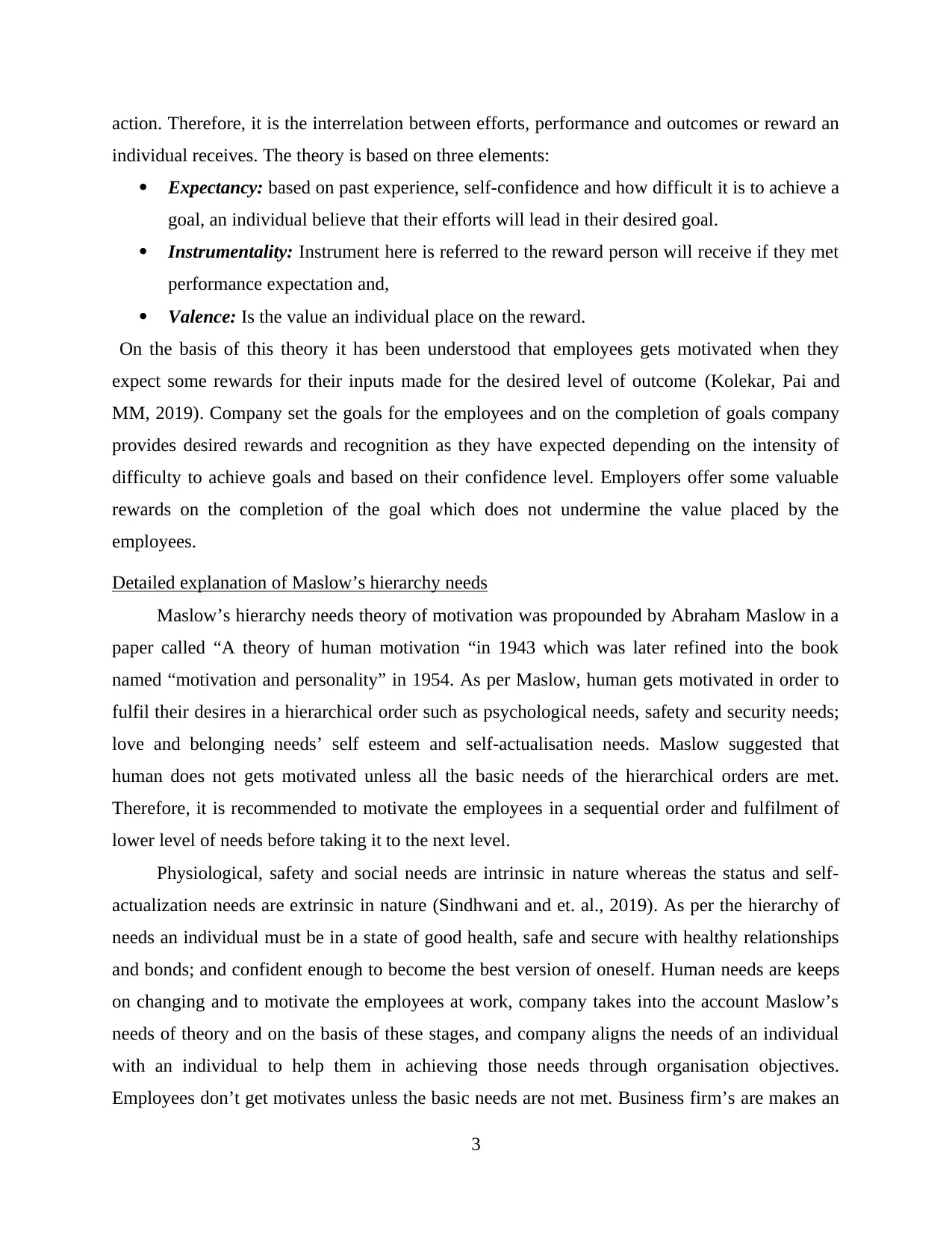
action. Therefore, it is the interrelation between efforts, performance and outcomes or reward an
individual receives. The theory is based on three elements:
Expectancy: based on past experience, self-confidence and how difficult it is to achieve a
goal, an individual believe that their efforts will lead in their desired goal.
Instrumentality: Instrument here is referred to the reward person will receive if they met
performance expectation and,
Valence: Is the value an individual place on the reward.
On the basis of this theory it has been understood that employees gets motivated when they
expect some rewards for their inputs made for the desired level of outcome (Kolekar, Pai and
MM, 2019). Company set the goals for the employees and on the completion of goals company
provides desired rewards and recognition as they have expected depending on the intensity of
difficulty to achieve goals and based on their confidence level. Employers offer some valuable
rewards on the completion of the goal which does not undermine the value placed by the
employees.
Detailed explanation of Maslow’s hierarchy needs
Maslow’s hierarchy needs theory of motivation was propounded by Abraham Maslow in a
paper called “A theory of human motivation “in 1943 which was later refined into the book
named “motivation and personality” in 1954. As per Maslow, human gets motivated in order to
fulfil their desires in a hierarchical order such as psychological needs, safety and security needs;
love and belonging needs’ self esteem and self-actualisation needs. Maslow suggested that
human does not gets motivated unless all the basic needs of the hierarchical orders are met.
Therefore, it is recommended to motivate the employees in a sequential order and fulfilment of
lower level of needs before taking it to the next level.
Physiological, safety and social needs are intrinsic in nature whereas the status and self-
actualization needs are extrinsic in nature (Sindhwani and et. al., 2019). As per the hierarchy of
needs an individual must be in a state of good health, safe and secure with healthy relationships
and bonds; and confident enough to become the best version of oneself. Human needs are keeps
on changing and to motivate the employees at work, company takes into the account Maslow’s
needs of theory and on the basis of these stages, and company aligns the needs of an individual
with an individual to help them in achieving those needs through organisation objectives.
Employees don’t get motivates unless the basic needs are not met. Business firm’s are makes an
3
individual receives. The theory is based on three elements:
Expectancy: based on past experience, self-confidence and how difficult it is to achieve a
goal, an individual believe that their efforts will lead in their desired goal.
Instrumentality: Instrument here is referred to the reward person will receive if they met
performance expectation and,
Valence: Is the value an individual place on the reward.
On the basis of this theory it has been understood that employees gets motivated when they
expect some rewards for their inputs made for the desired level of outcome (Kolekar, Pai and
MM, 2019). Company set the goals for the employees and on the completion of goals company
provides desired rewards and recognition as they have expected depending on the intensity of
difficulty to achieve goals and based on their confidence level. Employers offer some valuable
rewards on the completion of the goal which does not undermine the value placed by the
employees.
Detailed explanation of Maslow’s hierarchy needs
Maslow’s hierarchy needs theory of motivation was propounded by Abraham Maslow in a
paper called “A theory of human motivation “in 1943 which was later refined into the book
named “motivation and personality” in 1954. As per Maslow, human gets motivated in order to
fulfil their desires in a hierarchical order such as psychological needs, safety and security needs;
love and belonging needs’ self esteem and self-actualisation needs. Maslow suggested that
human does not gets motivated unless all the basic needs of the hierarchical orders are met.
Therefore, it is recommended to motivate the employees in a sequential order and fulfilment of
lower level of needs before taking it to the next level.
Physiological, safety and social needs are intrinsic in nature whereas the status and self-
actualization needs are extrinsic in nature (Sindhwani and et. al., 2019). As per the hierarchy of
needs an individual must be in a state of good health, safe and secure with healthy relationships
and bonds; and confident enough to become the best version of oneself. Human needs are keeps
on changing and to motivate the employees at work, company takes into the account Maslow’s
needs of theory and on the basis of these stages, and company aligns the needs of an individual
with an individual to help them in achieving those needs through organisation objectives.
Employees don’t get motivates unless the basic needs are not met. Business firm’s are makes an
3
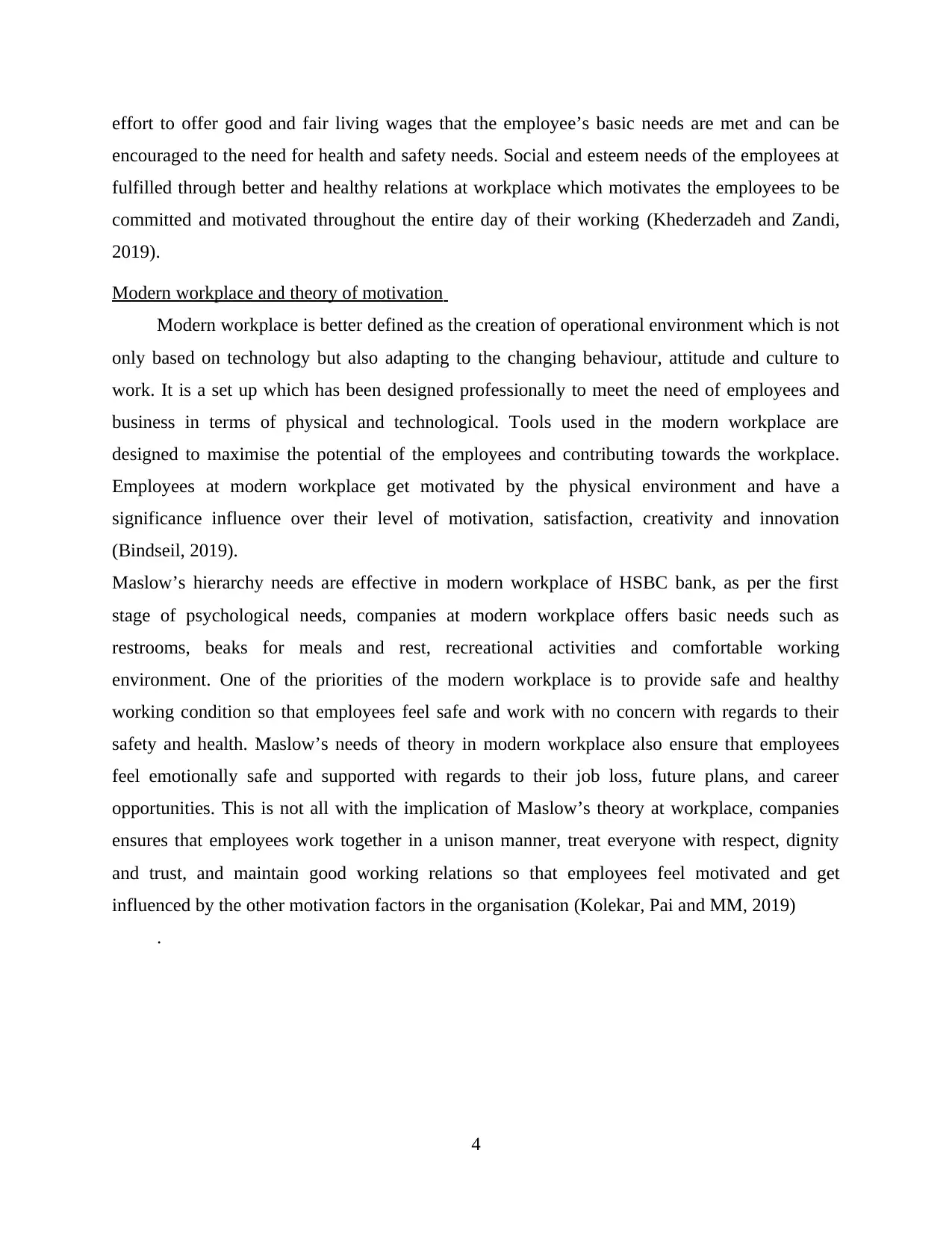
effort to offer good and fair living wages that the employee’s basic needs are met and can be
encouraged to the need for health and safety needs. Social and esteem needs of the employees at
fulfilled through better and healthy relations at workplace which motivates the employees to be
committed and motivated throughout the entire day of their working (Khederzadeh and Zandi,
2019).
Modern workplace and theory of motivation
Modern workplace is better defined as the creation of operational environment which is not
only based on technology but also adapting to the changing behaviour, attitude and culture to
work. It is a set up which has been designed professionally to meet the need of employees and
business in terms of physical and technological. Tools used in the modern workplace are
designed to maximise the potential of the employees and contributing towards the workplace.
Employees at modern workplace get motivated by the physical environment and have a
significance influence over their level of motivation, satisfaction, creativity and innovation
(Bindseil, 2019).
Maslow’s hierarchy needs are effective in modern workplace of HSBC bank, as per the first
stage of psychological needs, companies at modern workplace offers basic needs such as
restrooms, beaks for meals and rest, recreational activities and comfortable working
environment. One of the priorities of the modern workplace is to provide safe and healthy
working condition so that employees feel safe and work with no concern with regards to their
safety and health. Maslow’s needs of theory in modern workplace also ensure that employees
feel emotionally safe and supported with regards to their job loss, future plans, and career
opportunities. This is not all with the implication of Maslow’s theory at workplace, companies
ensures that employees work together in a unison manner, treat everyone with respect, dignity
and trust, and maintain good working relations so that employees feel motivated and get
influenced by the other motivation factors in the organisation (Kolekar, Pai and MM, 2019)
.
4
encouraged to the need for health and safety needs. Social and esteem needs of the employees at
fulfilled through better and healthy relations at workplace which motivates the employees to be
committed and motivated throughout the entire day of their working (Khederzadeh and Zandi,
2019).
Modern workplace and theory of motivation
Modern workplace is better defined as the creation of operational environment which is not
only based on technology but also adapting to the changing behaviour, attitude and culture to
work. It is a set up which has been designed professionally to meet the need of employees and
business in terms of physical and technological. Tools used in the modern workplace are
designed to maximise the potential of the employees and contributing towards the workplace.
Employees at modern workplace get motivated by the physical environment and have a
significance influence over their level of motivation, satisfaction, creativity and innovation
(Bindseil, 2019).
Maslow’s hierarchy needs are effective in modern workplace of HSBC bank, as per the first
stage of psychological needs, companies at modern workplace offers basic needs such as
restrooms, beaks for meals and rest, recreational activities and comfortable working
environment. One of the priorities of the modern workplace is to provide safe and healthy
working condition so that employees feel safe and work with no concern with regards to their
safety and health. Maslow’s needs of theory in modern workplace also ensure that employees
feel emotionally safe and supported with regards to their job loss, future plans, and career
opportunities. This is not all with the implication of Maslow’s theory at workplace, companies
ensures that employees work together in a unison manner, treat everyone with respect, dignity
and trust, and maintain good working relations so that employees feel motivated and get
influenced by the other motivation factors in the organisation (Kolekar, Pai and MM, 2019)
.
4
⊘ This is a preview!⊘
Do you want full access?
Subscribe today to unlock all pages.

Trusted by 1+ million students worldwide
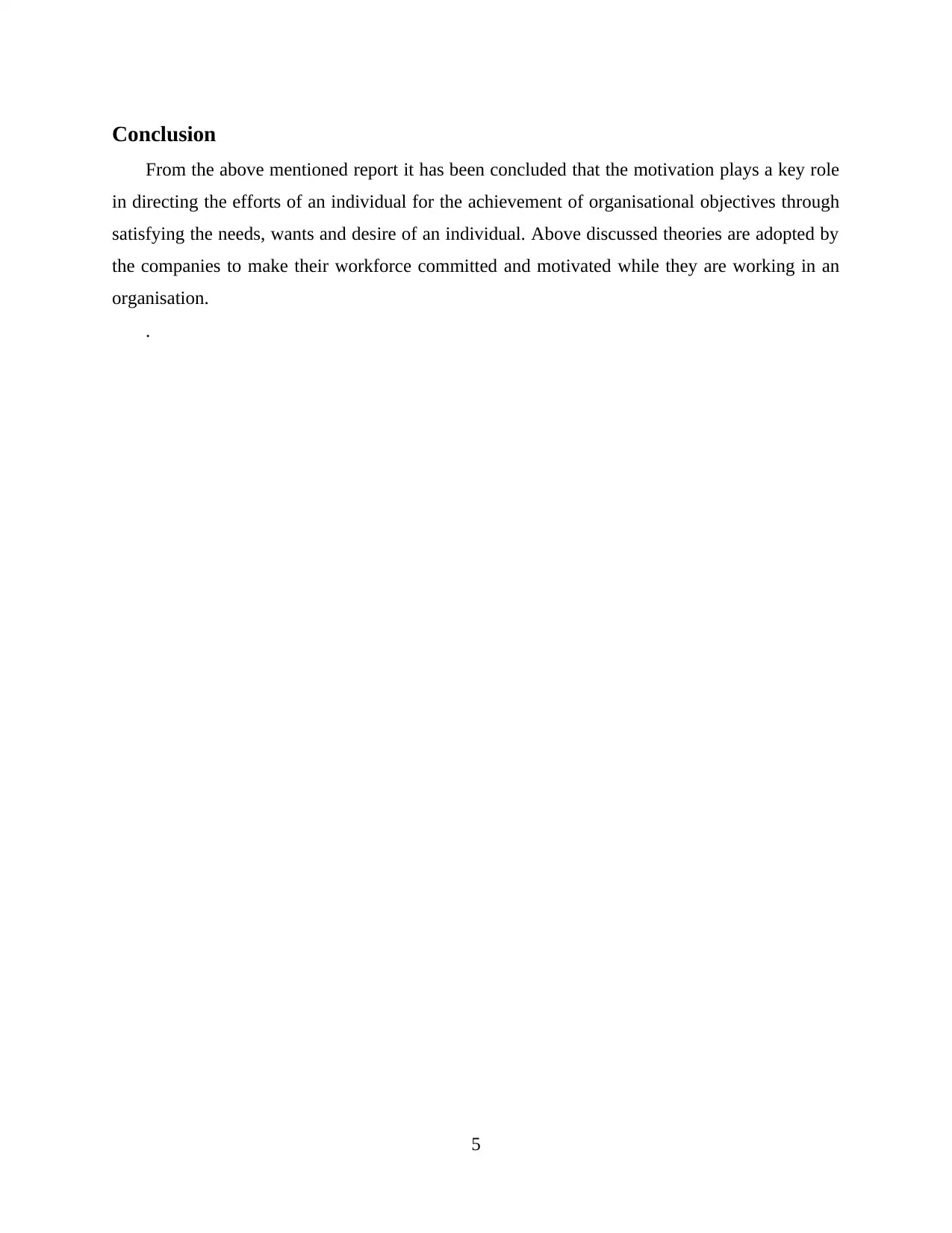
Conclusion
From the above mentioned report it has been concluded that the motivation plays a key role
in directing the efforts of an individual for the achievement of organisational objectives through
satisfying the needs, wants and desire of an individual. Above discussed theories are adopted by
the companies to make their workforce committed and motivated while they are working in an
organisation.
.
5
From the above mentioned report it has been concluded that the motivation plays a key role
in directing the efforts of an individual for the achievement of organisational objectives through
satisfying the needs, wants and desire of an individual. Above discussed theories are adopted by
the companies to make their workforce committed and motivated while they are working in an
organisation.
.
5
Paraphrase This Document
Need a fresh take? Get an instant paraphrase of this document with our AI Paraphraser
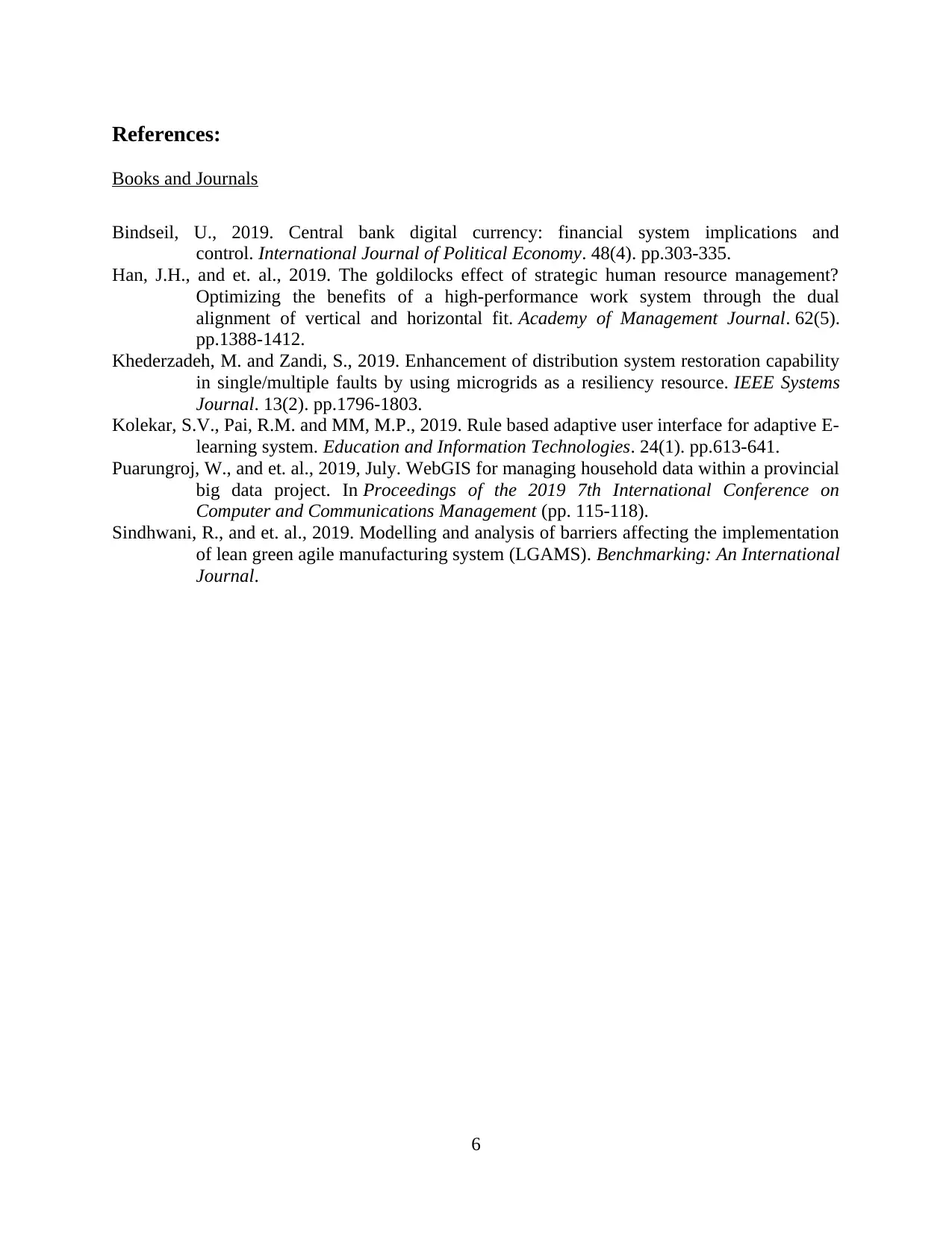
References:
Books and Journals
Bindseil, U., 2019. Central bank digital currency: financial system implications and
control. International Journal of Political Economy. 48(4). pp.303-335.
Han, J.H., and et. al., 2019. The goldilocks effect of strategic human resource management?
Optimizing the benefits of a high-performance work system through the dual
alignment of vertical and horizontal fit. Academy of Management Journal. 62(5).
pp.1388-1412.
Khederzadeh, M. and Zandi, S., 2019. Enhancement of distribution system restoration capability
in single/multiple faults by using microgrids as a resiliency resource. IEEE Systems
Journal. 13(2). pp.1796-1803.
Kolekar, S.V., Pai, R.M. and MM, M.P., 2019. Rule based adaptive user interface for adaptive E-
learning system. Education and Information Technologies. 24(1). pp.613-641.
Puarungroj, W., and et. al., 2019, July. WebGIS for managing household data within a provincial
big data project. In Proceedings of the 2019 7th International Conference on
Computer and Communications Management (pp. 115-118).
Sindhwani, R., and et. al., 2019. Modelling and analysis of barriers affecting the implementation
of lean green agile manufacturing system (LGAMS). Benchmarking: An International
Journal.
6
Books and Journals
Bindseil, U., 2019. Central bank digital currency: financial system implications and
control. International Journal of Political Economy. 48(4). pp.303-335.
Han, J.H., and et. al., 2019. The goldilocks effect of strategic human resource management?
Optimizing the benefits of a high-performance work system through the dual
alignment of vertical and horizontal fit. Academy of Management Journal. 62(5).
pp.1388-1412.
Khederzadeh, M. and Zandi, S., 2019. Enhancement of distribution system restoration capability
in single/multiple faults by using microgrids as a resiliency resource. IEEE Systems
Journal. 13(2). pp.1796-1803.
Kolekar, S.V., Pai, R.M. and MM, M.P., 2019. Rule based adaptive user interface for adaptive E-
learning system. Education and Information Technologies. 24(1). pp.613-641.
Puarungroj, W., and et. al., 2019, July. WebGIS for managing household data within a provincial
big data project. In Proceedings of the 2019 7th International Conference on
Computer and Communications Management (pp. 115-118).
Sindhwani, R., and et. al., 2019. Modelling and analysis of barriers affecting the implementation
of lean green agile manufacturing system (LGAMS). Benchmarking: An International
Journal.
6
1 out of 8
Related Documents
Your All-in-One AI-Powered Toolkit for Academic Success.
+13062052269
info@desklib.com
Available 24*7 on WhatsApp / Email
![[object Object]](/_next/static/media/star-bottom.7253800d.svg)
Unlock your academic potential
Copyright © 2020–2025 A2Z Services. All Rights Reserved. Developed and managed by ZUCOL.




